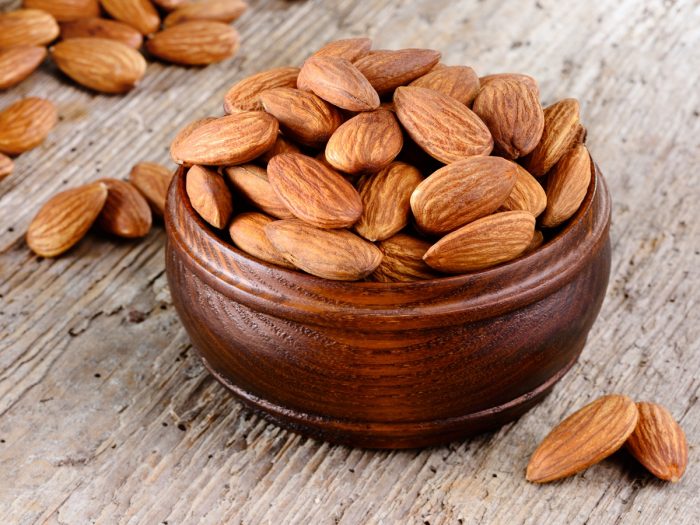For many pet owners, when dogs eat almonds, it can be a worrying experience, as there are some foods that can be toxic to canine companions. It is important to understand that almonds are not a wise choice as a snack, along with understanding all the risks and potential benefits of any human food that finds its way into your dog’s diet.
Can Dogs Eat Almonds?
While humans often think of almonds as a healthy snack full of beneficial fats and minerals, the same isn’t true for dogs. When dogs eat almonds, it can cause an increased risk of certain health conditions, such as pancreatitis, among others. The problem is that dogs aren’t able to properly digest many of the proteins found in almonds, as well as many other nuts. This can cause gastrointestinal distress and a number of other symptoms. While almonds might be a nut you often have lying around your house, you should avoid tossing any to your pooch. [1]
Furthermore, any normal diet for your dog should provide all the nutrients that you need, so any human food should be considered an occasional treat, rather than a regular meal supplement. The high level of fat found in almonds, other risks notwithstanding, would make these nuts a poor choice for your pup. Many dog owners like to give their dogs peanut butter, which lends itself to a natural question – can dogs eat almond butter?
In the case of this increasingly popular spread, it is okay for your dog to consume it in very limited quantities. Some of the minerals and vitamins are more bioavailable in this form, and it won’t be as difficult for your dog to digest. That being said, some kinds of almond butter will contain harmful chemicals or additive, such as xylitol, and should be strictly avoided. Look for an all-natural, unsalted and unsweetened variety of almond butter if you plan to share any with your dog. Salted varieties will lead to more water retention. [2]
As a general rule, keep your dogs away from nuts, as the risks tend to outweigh any possible benefits, but if your pup eats one or two fallen almonds off the floor, there is no reason to panic. Eating larger amounts of almonds is when the danger starts. [3]

A bowl of rich brown almonds. Photo Credit: Shutterstock
Dangers of Dogs Eating Almonds
When dogs eat almonds, the primary risks include gastrointestinal distress, pancreatitis, obesity, and potential infections, among others.
Gastrointestinal Distress
As mentioned above, the inability of dogs to digest the proteins in almonds will lead to gastric distress, such as diarrhea, vomiting, greasy stools or apparent dehydration, abdominal pain, fever, and weakness. For obvious reasons, it is best to avoid these symptoms, which don’t require the consumption of many almonds. [4]
Obesity
Almonds and nuts, in general, are very high in fat, which is a major issue for dogs who struggle with weight issues. A balanced diet of kibble and dog food will provide all the fat and nutrients that your pooch should have. Adding exorbitant amounts of nuts will only increase their risk of heart trouble, diabetes, and arthritis as they age. [5]
Pancreatitis
The anatomy of dogs isn’t quite the same as humans, and excess amounts of certain foods have a more serious impact on their overall health. For example, when dogs eat a high-fat diet, their risk of pancreatitis rises significantly. [6]
Infections
Some almonds may have been exposed to toxins or certain types of mold to which dogs are particularly susceptible. While this is rare, some of the potential toxins in almonds can be very dangerous for your dogs.
